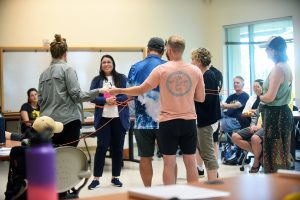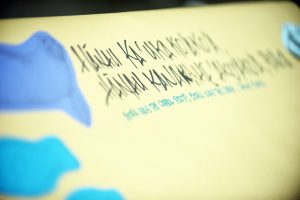Although the last day of any experience is often bittersweet, our potluck dessert table made…
Daily Manaʻo for Cohort Kumukahi March 2024 – Wednesday
Wednesday, March 20, 2024
Our day at the ʻili ʻāina of Kaʻākaukukui began beneath the Waʻahila rain. As my team and I walked throughout the mounds of Kakaʻako Waterfront Park to scope out our location for the day, we followed the meandering sidewalks to the oceanfront view of the southern coast of Oʻahu. To our right, to the ʻEwa side of the shoreline, we could see Ke Awa o Kou, Honolulu Harbor colored with the faded metal of shipping containers being unloaded at the piers. Behind us lay a great mound of earth, and our hoʻokele Punihei noted that, back in the day, this puʻu was a gathering place where some of the first courses for people at UH Mānoa who studied the stars and night sky for navigational purposes were taught. ʻAoʻaoa, the southern sea wind of Māmala Bay, would come to join us closer to midday once the sun rose higher in the sky.
In transitioning from a day at Kānewai, we greeted Kanaloa in the vast expanse of deep blue ocean hues as the thundering waves sprayed sea mist into the winds. We offered the oli of Welina Mānoa to the direction of Mānoa valley, and we took the time to acknowledge the layers of ʻāina and the histories that hosted us for a day at Kakaʻako. As we moved through exercises that asked us to trace our moʻokūʻauhau, we also acknowledged the many lineages that shape us into the people we are today. Moʻokūʻauhau not only represent our biological ancestors but our predecessors who have shaped us—including intellectually and through our ʻāina relations. In response, we were met with two koholā, a parent and a baby whale, who were surfacing just offshore from where we were gathered. The time that they spent with us was their act of recognition as we called the famous names of Kaʻākaukukui back into living memories.
For the second half of our day at Kakaʻako, we then transitioned to the John A. Burns School of Medicine (JABSOM), where a few of our cohort members very graciously hosted us. Wet met beneath the shade of kukui trees in the māla and offered Welina Mānoa before receiving a response oli welcoming us into their space. And it is a beautiful space indeed—medicine surrounded us in the many vertical layers of our time in their māla. Listening closer, we heard the story of a tall ʻōhiʻa lehua that once grew well and strong on their campus, but once the tap root hit the salt water beneath the earth, it came down. Looking up, we noticed designs of native plants and kapa patternings etched into the architecture of their buildings that further supported the interconnectivity between health and ʻāina.
As we continued to delve deeper into the concepts of moʻokūʻauhau, kaikuaʻana, kaikaina, and kuleana, we introduced an interactive activity that would spatially indicate the dynamic movements of these complex relations. We often repeated the truth that our kuleana are dynamic—kuleana changes constantly, and it might be difficult for us to keep track of the shifting, moving parts. The Piko Exercise, which we humbly credit Kumu Noelani Goodyear-Kaʻōpua with creating, allows us to see how each of us are distanced differently from a central piko—those of us who have more pilina to a given ʻāina will find ourselves in closer proximity to the central piko, while those of us who are less familiar with that place will be more distanced from that ʻāina. Either way, we are still connected to the piko and to each other.


